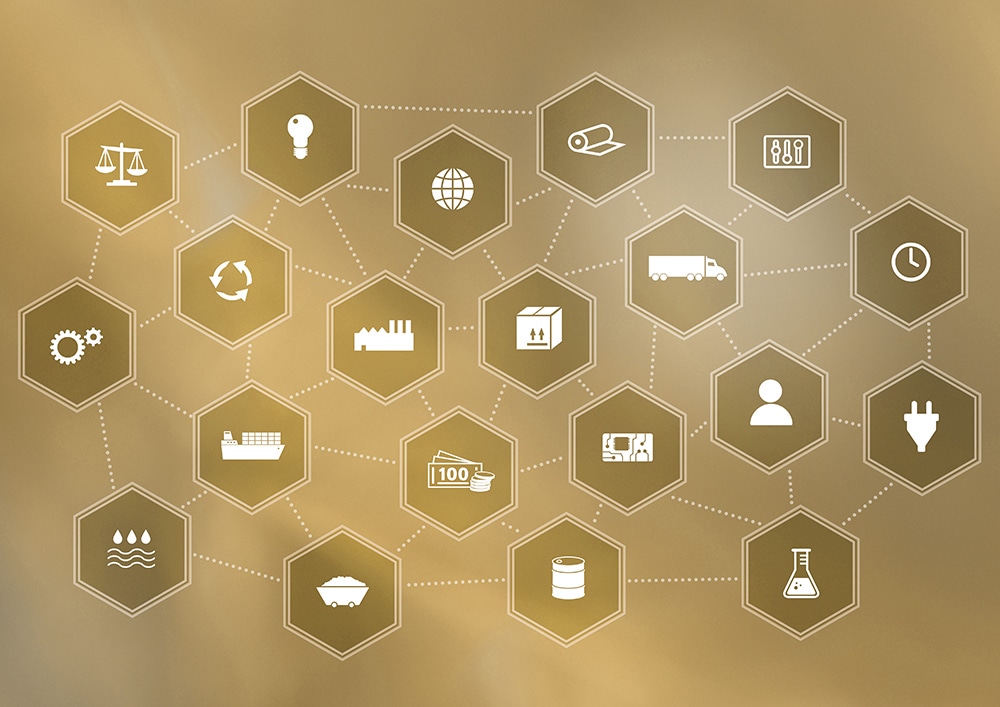
Material system analysis (MSA)
Material System Analysis (MSA) consists of a map of the flows of materials through the economy, as raw materials or as parts of basic materials, components or products, in terms of entry into the economy (extraction and import), movement through the economy (production, consumption, exports), additions to stock, and end-of-life through either disposal or recovery. An MSA also includes information about the sustainability of the use of materials and the security of supply. The Material System Analysis includes the materials consumed in the EU and their associated flows over the entire life cycle, including exploration, extraction, processing, manufacturing, use, and end of life disposal and treatment.
A secure and sustainable supply of raw materials is the backbone of the green and digital transition and fulfilling the green deal. The MSA are a vital tool for monitoring our security of supply for specific raw materials, as well as their performance in the circular economy.
The European Commission performed the first MSA study in 2015, covering a range of 28 raw materials. These were later complemented by dedicated studies on base metals, battery raw materials, and materials becoming critical after 2014. The initial study was updated and expanded in 2023.
The MSA studies aim to build knowledge and understanding of Europe's critical raw materials' flows. The current MSA coverage includes 37 materials.
List of raw materials studied:
- Aggregates (2015, 2023)
- Aluminium (2018)
- Antimony (2015, 2023)
- Barytes (2021)
- Beryllium (2015, 2023)
- Bismuth (2021)
- Boron/Borates (2015, 2023)
- Chromium (2015, 2023)
- Cobalt (2015, 2020)
- Coking Coal (2015, 2023)
- Copper (2018)
- Fluorspar (2015, 2023)
- Gallium (2015, 2023)
- Germanium (2015, 2023)
- Hafnium (2021)
- Helium (2021)
- Indium (2015, 2023)
- Iron (2018)
- Lithium (2015, 2023)
- Magnesite (2015, 2023)
- Magnesium (2023)
- Manganese (2015, 2020)
- Natural Graphite (2015, 2020)
- Natural Rubber (2021)
- Nickel (2015, 2020)
- Niobium (2015, 2023)
- Phosphate Rock (2015, 2023)
- Phosphorus (2021)
- Platinum Group Metals: Palladium, Platinum, and Rhodium (2015, 2023)
- Rare Earth Elements (2015, 2023)
- Scandium (2021)
- Silicon Metal (2015, 2023)
- Strontium (2023)
- Titanium (2023)
- Tantalum (2021)
- Tungsten (2015, 2023)
- Vanadium (2021)
For each material, this first-ever EU-wide MSA consists of:
- A map of material flows (as raw materials, components, products) illustrating entry (extractions, imports into the EU) and movement (production, consumption, exports out of the EU) through the EU economy, additions to stock, and end-of-life disposal or recovery;
- Information on security of supply (country concentration), substitutes, and projected future demand of materials.
The parameters aim to describe physical flows and stocks along the life cycle of the material, characterise the criticality of the material or forecast future supply and demand.

MSA Reports
- Material System Analysis of 28 raw materials - Final Report (2015): EN
- Material System Analysis of 28 raw materials - Summary (2015): EN FR DE
- Material System Analysis of 3 raw materials: Aluminium, Copper, Iron (2018): EN
- Revised of the Material System Analyses specifications (2020): EN
- Material System Analysis of 5 Battery Raw Materials: Cobalt, Lithium, Manganese, Natural graphite, Nickel (2020): EN
- Material System Analysis of 9 Raw Materials : Barytes, Bismuth, Hafnium, Helium, Natural Rubber, Phosphorus, Scandium, Tantalum and Vanadium (2021): EN
- Update of the 2015 Material System Analysis - Final Report (2023): EN FR DE
Links
RMIS related pages
- Raw materials' profiles
- Critical, strategic and advanced materials
- Modelling plastic flows in the European Union value chain
European Commission pages
- DG Growth – “Critical” raw materials page
- DG Growth – Raw materials, metals, minerals and forest-based industries
Selected documents
- Communication from the EC on the Raw Materials Initiative "Meeting our critical needs for growth and jobs in Europe", 2008
- Report from the Commission on the implementation of the Raw Materials Initiative
- Critical raw materials for the EU – May 2014 – Report on Critical raw materials for the EU
